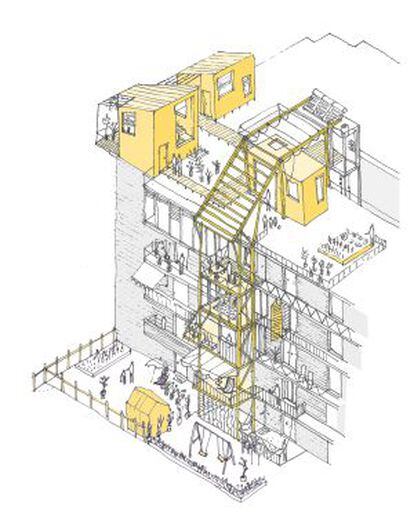The neighborhood that could become a global example of revival
Spanish team wins UN prize for plans to create community-based housing in Valencia district


A project designed by two Spanish architects has won a UN competition to create sustainable solutions for mass urban housing. Recooperation, presented by María García and Gonzalo Navarrete of architectural firm Improvistos is a project to revitalize the run-down Orba neighborhood in Alfafar, in the southern outskirts of Valencia, which was built in the 1960s to house the families of workers employed in a nearby timber plant that has since closed, prompting an exodus from the area.
Orba’s housing stock is made up of just two types of low-quality, identical 70- and 90-square-meter apartments in blocks laid out on a grid system, originally designed to house around 6,000 people.
Improvisto’s project is based on the principle of cohousing, an approach that is popular in Scandinavia
Improvisto’s project is based on the principle of cohousing, an approach that is popular in Scandinavia, where communities consist of private homes with shared facilities, and where residents play an active role in how the community is designed and managed.
“A neighborhood community can have different degrees of privacy and take advantage of under-utilized areas for shared services, or by generating economic activities that finance projects within the community,” says García. The plan proposes using unoccupied properties for common use, such as laundries or study areas. At the same time spare rooms in larger properties occupied by a single resident could be used whereby the community gains space and the occupant saves on costs.

García and Navarrete say their idea is for space to be utilized according to the community’s needs, with extensions, annexing of adjoining apartments, or the reduction of the size of properties carried out as required. The concept is also known as progressive architecture, whereby instead of buying a property of a fixed size, residents can add or remove rooms according to their needs and resources. In the case of Orba, this approach has been applied to the apartment blocks, where Improvistos says changes can “be implemented that would considerably increase diversity at low cost and without affecting load-bearing walls.”
Improvisto’s project also proposes the use of renewable energy sources such as solar power and biomass, as well as restructuring the allotments that some neighbors have already created, using recycled water for irrigation. They also highlight the need to recover some key buildings in the area, such as the high school, which is no longer in use, as well as a shopping center and market, which at one time was the cornerstone of the community, but is now virtually in ruins. The architects say that they also plan to develop a nearby tree nursery in the hope of creating jobs in an area that has been hard hit by unemployment.
The rules of the UN-Habitat Revitalization of Mass Housing International Competition require participants to take into account several considerations: projects must improve urban public spaces and provide mobility for residents; they must include economic revitalization by introducing new activities that generate jobs; they must have a strong social component, addressing the needs of residents in terms of child care, while providing a safe environment; they must be sustainable, preferably with an agricultural component; and bring residents, local administration, education, and business together to find long-term joint solutions.
Instead of buying a property of a fixed size, residents can add or remove rooms according to their needs
So what happens next? The two architects say that their proposal is still open to further changes and development.
“This proposal is just an example of how a system of exchange and creating shared spaces can work,” García explains. “We are interested in working with something already existing, both in terms of physical structures and the social fabric of the neighborhood: we have come up with some suggestions, but there are many more possibilities. We aim to continue working with residents and local politicians further.”
Sergio Miguel Guillem, a local councilor responsible for town planning, says that he is prepared to take the project further by discussing it with local residents, and to then look for financing. He points out that as this is an external proposal, there is no budget, but he remains skeptical about its viability: “We are working on less Utopian ideas such as the new IKEA [the first of the Swedish furniture store’s outlets in Valencia opened in June in Alfafar]. We are very busy, and have only had a chance to look over it quickly, but we will try to study it in more detail and talk to residents and the Polytechnic University of Valencia, which has also come up with some plans for the neighborhood,” he says.
Most local residents seem to be largely unaware of the proposals to revitalize their neighborhood. Local media have hardly covered the UN-Habitat prize, and the local town hall has yet to comment officially. Orba is just one of three similar districts built in the 1960s in Valencia’s southern flank; the other two, Massanasa a Alfafar and Benetusser, also have poor housing stock and high unemployment.
This proposal is an example of how a system of exchange and shared spaces can work” Improvistos architects
That said, there is small and very active group of residents, most in their sixties, who believe in the project and who are working hard to raise awareness. Most of them have lived in Orba since it was built, and have long been active at the community level.
Julián Moyano Reiz of the residents’ association says that it is important to maintain the momentum created by the UN award for Improvisto’s project. “It’s a big opportunity, they have given us a project that we can use as we wish, change, develop, discuss, and it would be dumb not to do so. The UN prize is an incentive to look for financing that would normally be beyond our reach,” he says, adding that the local council remains unimpressed. “We have tried to arrange a meeting, but for the moment, they won’t see us. They only come round when there are elections. I don’t think that they have any intention of taking this anywhere,” says Moyano Reiz.
Getting Recooperation off the ground would certainly require a great deal of cooperation: firstly, the local council would need to get involved, then there would have to be consensus among the residents of Orba, and finally, the biggest problem: financing.
Orba is typical of hundreds of unprivileged, under-resourced neighborhoods in the outlying areas of Spain’s big cities: its population grew rapidly a decade ago during the construction boom, which brought immigrants in; when the Spanish economy collapsed in 2008, huge numbers of jobs were lost at the same time as local authorities cut spending. Now Orba has the chance to become an example of how such neighborhoods can become vibrant, dynamic places where local people have a say in their affairs.










































